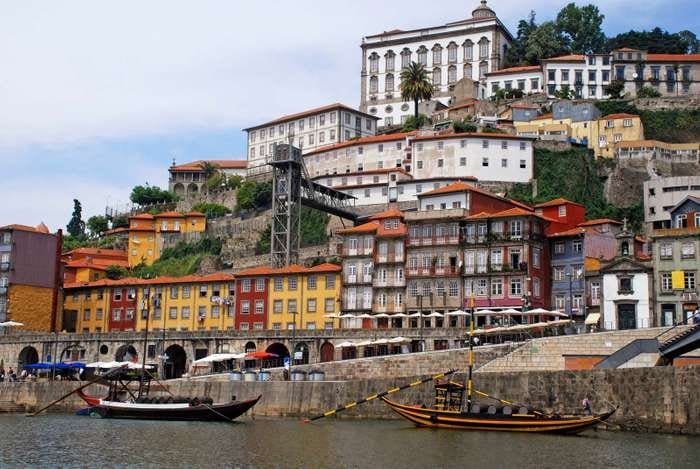Portugal, officially Portuguese Republic, Portuguese República Portuguesa, country lying along the Atlantic coast of the Iberian Peninsula in southwestern Europe. Once continental Europe’s greatest power, Portugal shares commonalities—geographic and cultural—with the countries of both northern Europe and the Mediterranean. Its cold, rocky northern coast and mountainous interior are sparsely settled, scenic, and wild, while the country’s south, the Algarve, is warm and fertile. The rugged Estrela Mountains (Serra da Estrela, or “Star Mountain Range”), which lie between the Tagus and Mondego rivers, contain the highest point of mainland Portugal.

Lisbon is Portugal’s capital and economic and cultural centre. The city clings to low but steep hills situated on the right bank of the Tagus and is a popular tourist destination. Lisbon is rather more tranquil and reserved than Madrid in neighbouring Spain, but it shares with it a reputation for great food, melancholy and romantic music, dance, and sport. Portuguese traditionally have prized a simple and unostentatious life, favouring the rural over the urban and the traditional to the modern, where a fine meal might consist of carne de porco à Alentejana (lean pork stuffed with clams), thick-crusted bread, and dark wine. Portuguese delight in the countryside, where they gather to hold family picnics, tend to their gardens and orchards, and relax. It is from the countryside that the fado, a form of romantic ballad, is thought to have come (though it is now clearly associated with the cities of Lisbon and Coimbra), and it is in the countryside that the country’s traditional sport of bullfighting takes its finest form, though in Portuguese bullfighting the bull is not killed but rather is retired to the countryside for the rest of its life.
Cultural Life
Portuguese culture is based on a past that dates from prehistoric times into the eras of Roman and Moorish invasion. All have left their traces in a rich legacy of archaeological remains, including prehistoric cave paintings at Escoural, the Roman township of Conimbriga, the Roman temple (known as the Temple of Diana) in Évora, and the typical Moorish architecture of such southern towns as Olhão and Tavira. Throughout the centuries Portugal’s arts have been enriched by foreign influences, including Flemish, French, and Italian. The voyages of the Portuguese explorers, such as Ferdinand Magellan, who was the first to circumnavigate the globe, and Vasco da Gama, who pioneered an eastern route to Asia around the Cape of Good Hope (the first European to sail around the cape was another Portuguese navigator, Bartolomeu Dias, in 1488), opened the country to Asian influences, and the revelation of Brazil’s wealth of gold and jewels fed the Baroque flame in decoration. There have been considerable efforts to conserve architecture and art across the country, especially religious artifacts, palaces, and the several distinctive styles of casas portuguesas, or modest homes. Preservation has led to the declaration of the city centres of Évora, Sintra, Porto, and, in the Azores, Angra do Heroísmo as UNESCO World Heritage sites.

Roman temple, known as the Temple of Diana, in Évora, Portugal

Pena Palace, Sintra, Portugal
Daily life and Social customs
Despite certain affinities with the neighbouring Spaniards, the Portuguese have their own distinctive way of life. The geographic variety of the country has evoked different responses, but there is less regionalism than in Spain. Moreover, lifestyles have altered radically as rural populations have declined and cities and their suburbs have expanded. Urban centres provide a range of entertainment, and fairs and markets are highlights of social gatherings. A long tradition of dancing and singing continues among the Portuguese. Nearly every village has its own terreiro, or dance floor, usually constructed of concrete, though in some places it is still made of beaten earth. Each region has its own style of dances and songs; most traditional songs are of a slower rhythm than those in Spain. Small accordions and gaitas, or bagpipes, are among a considerable range of instruments that accompany dances, and Portuguese guitars (and sometimes violas) accompany the fado, a song form that epitomizes saudade—the yearning, romantic aspect of the Portuguese character. Regional dances, which include the vira, chula, corridinho, tirana, and fandango, often reflect the courting and matrimonial traditions of the area. Much has been done to preserve these and other folk expressions as tourist attractions.
National dress is still seen in the northern Minho province at weddings and other festivals. Traditional garments such as the red and green stocking cap of the Alentejo cattleman still exist, and the samarra (a short jacket with a collar of fox fur) and cifões (the equestrian’s leather chaps) survive. Rustic plows and wooden carts drawn by oxen or mules are still used by small farmers (though in the perennial battle against forest fires, shepherds who guard their flocks in forest areas have been supplied with mobile phones). The wearing of black for protracted periods of mourning is common, especially in the villages.
Cotton Weaving

Because of colonial influences in Brazil, Portugal’s cotton industry took form during the eighteenth century with production centered in Lisbon. By importing the necessary machinery from Britain, the Portuguese were able to outfit dozens of factories and set their economy in motion.
By the time the nineteenth century rolled around, Portugal had begun to explore another niche within the textile industry: Linen production. With flax fibers imported from Hamburg, the country was well-positioned to specialize within the industry – especially in northern regions, like the city of Guimaraes where a collection of small rivers provided the necessary water supply. Some linen producers spun fibers, while others wove them together to form the impressive fabrics we use here at Parachute. Linen was particularly popular for use in garments; the dyeing process was free of harsh, irritating chemicals and yielded a supple textile that became increasingly soft with laundering. Unlike the cotton industry, the linen trade was not factory-based. It began as a domestic pastime, and people would weave their own linens on small, household looms.
Traditional Costumes
The Portuguese traditional costumes are diverse and good-looking. Some of them even look a bit weird. But, as with most national outfits around the planet, there is an explanation to each variety, each shape, and each design of dresses. Different regions of Portugal are characterized by different folk clothing – farmers had their specific garments, fishermen wore other clothes, the attire of cattlemen had another design, and so on.
Traditional clothing
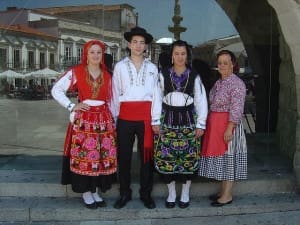
Throughout most of Portugal’s history its people were poor farmers and fisher folk. Because the rural areas were very isolated, traditional clothing was worn until well into late 20th century. The materials were very colourful due to patterns woven into the cloth and embroidery. The design of the clothes tends to be conform across the country, though there are regional differences. Red and black are the two most popular colours.

A Mordoma (a woman in charge of the house servants) in full costume with gold jewellery
Traditional women’s costumes typically consist of long bouffant skirts (saia) with vibrant checked or striped patterns (most often in red and white) with a blouse and sometimes a waistcoat/bodice. Highly embroidered aprons are worn over the skirt. The outfit is completed with a headscarf to cover the hair. Traditionally, women wear several ornate gold necklaces and finish their outfit with a matching headscarf worn in a variety of ways: ends hanging down, tied under the chin or behind the neck.
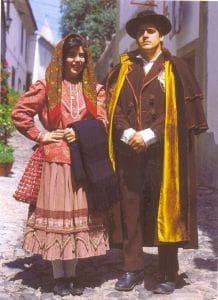
Atlentjo man and woman
Traditionally, Portuguese men wear short trousers to just below the knees or long trousers, waistcoats and sombreros.
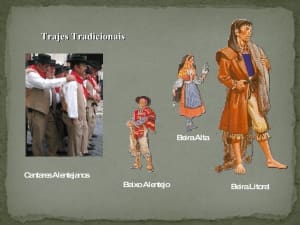
Men from Atlentjo wearing different costumes and a woman from the same region
Alentejo cattleman are well-known for their trademark red and green stocking cap. This traditional dress is still worn in some areas, along with the samarra, a short jacket accented with a collar of fox fur.
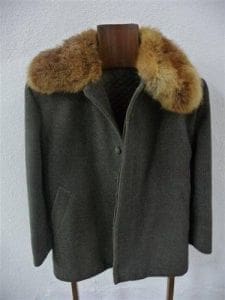 A samarra showing the fox-fur collar
A samarra showing the fox-fur collar
In the Trás-os-Montes e Alto Douro region, shepherds continue to dress in the traditional straw cloak.
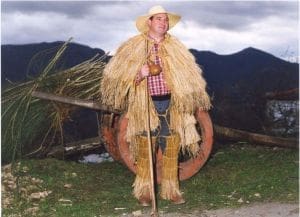
Straw cloak
Black felt hats are worn by both women and men in a variety of styles. Women wear porkpie hats with a narrow brim, while men wear narrow- or wide-brimmed hats in the Spanish style. The women wear their hats over a headscarf.

Portuguese hats
While traditional dress is not widely worn nowadays, it is still used at weddings and festivals.
Handicrafts
Portugal has a great tradition of handicrafts. Each region of Portugal have their own crafts for example Alentejo is best known for its hand painted pottery, wooden chairs and cork products and world famous Arraiolos rugs. The Portuguese are proud of their traditional crafts and hand down their techniques through the generations.


Hand Painted Pottery
The Portuguese have always found ways of using their natural resources, cork being a good example. They are the biggest producers of corks supplying to the world’s leading wine countries, but with the arrival of the screw top and plastic corks, the industry dealt with a severe blow. Undeterred, cork is now used in the making of shoes, handbags and purses which are sold world over.

Cork Shoes

Cork Purses
Jewellery
For centuries the Portuguese jewellery scene has been dominated by traditional, delicate filigree jewellery, crafted from fine strands of precious metals woven together to create ornate, elaborate motifs. However in recent years the country has seen something of a jewellery revolution, with younger designers creating bolder, more contemporary and innovative designs.


The ancient art of filigree, ‘filigrana’ in Portuguese, predates the Roman period, making it one of the oldest jewellery-making techniques on record. Believed to have originated in Asia, filigree found its way across the continents and became extremely popular in 12th-century Portugal. Once it had made its way into Western Europe, filigree was combined with the typical styles of the times to create gold and silver metalwork, often rich in religious iconography, and presented as gifts to the nobility.

Bride And Groom in Portuguese wedding attire
The country’s love of filigree continued throughout the centuries and Portuguese jewellery’s fine, intricate designs became one of the best examples of the technique. However in recent years, designers have begun to create bolder, more contemporary and innovative designs which, while still finding inspiration in the country’s rich jewellery heritage, are redefining the concept and image of Portuguese jewellery.
Nature is certainly one of the strongest influences among the new wave of contemporary Portuguese jewellery designers. From ancient filigree jewellery and the natural environment around them to their country’s own creative spirit, the new wave of Portuguese jewellers enjoys rich local sources of inspiration to draw upon.
REFERENCES:
- https://www.britannica.com/place/Portugal
- https://babogenglish.wordpress.com/2017/12/06/portugal-general-information/
- http://www.mrsroomtobreathe.com/2014/01/traditional-portuguese-handicrafts.html
- https://www.pinterest.pt/cgprintdesign/portuguese-crafts/
- https://happyportugal.pt/en/artesanato/
- https://blog.parachutehome.com/history-of-portuguese-textiles/
- https://www.globalblue.com/destinations/portugal/guide-to-portuguese-jewellery/#:~:text=For%20centuries%20the%20Portuguese%20jewellery,to%20create%20ornate%2C%20elaborate%20motifs.
- http://saloia.blogspot.com/2007/08/filo-granum.html
- http://portoarc.blogspot.com/2013_07_01_archive.html
Article written by: Arwa Aamir Kalawadwala
M.Sc. in Textile and Fashion Technology
College of Home Science, Nirmala Niketan.
Textile Value Chain Intern.

